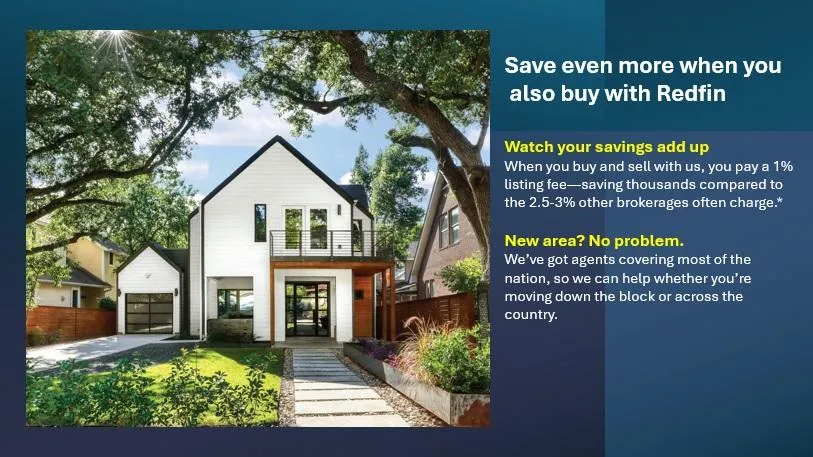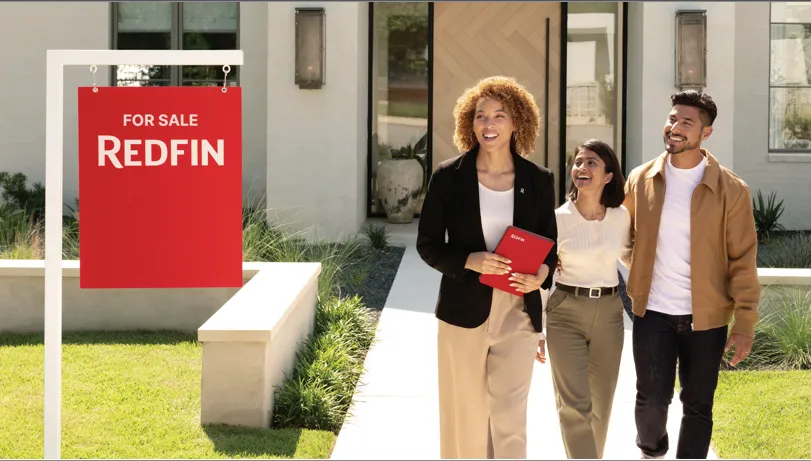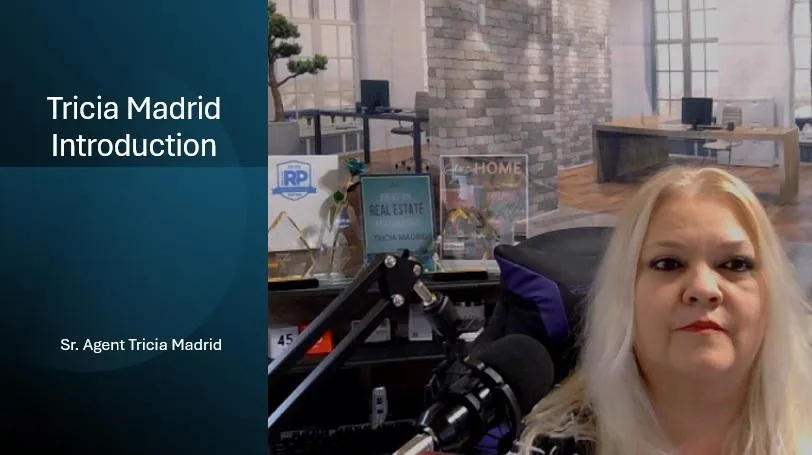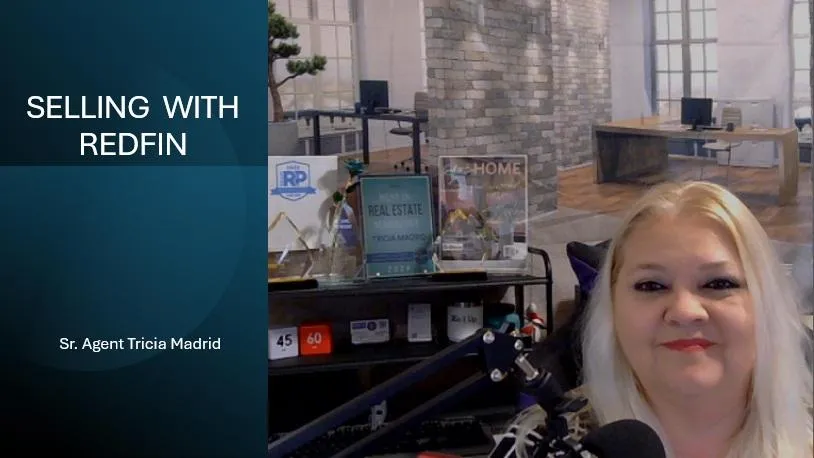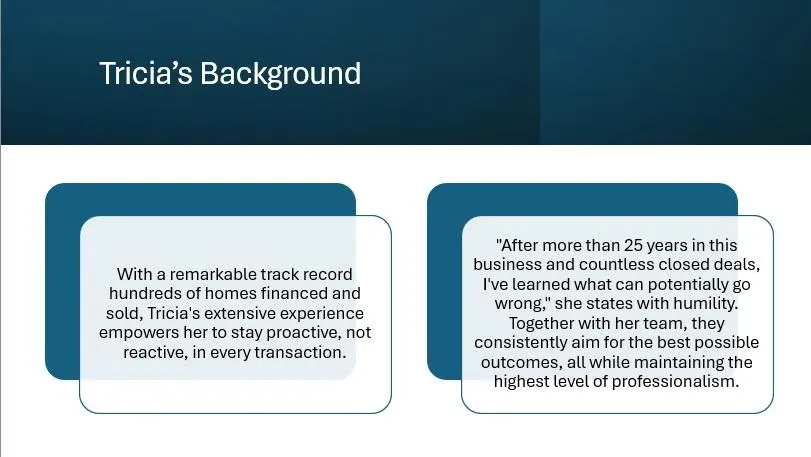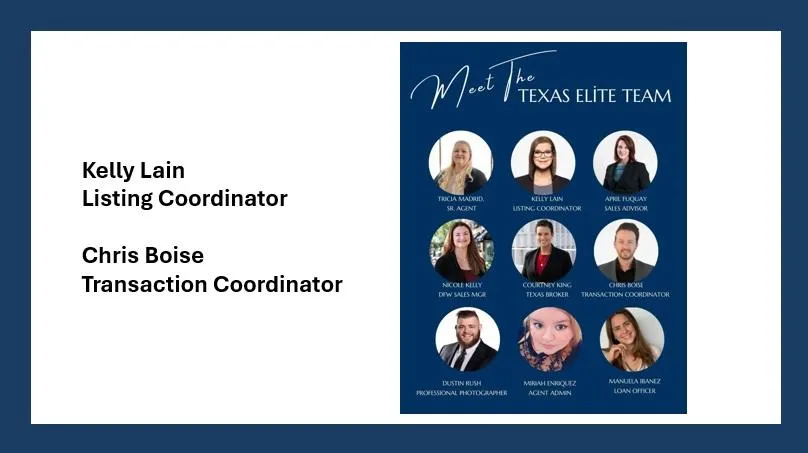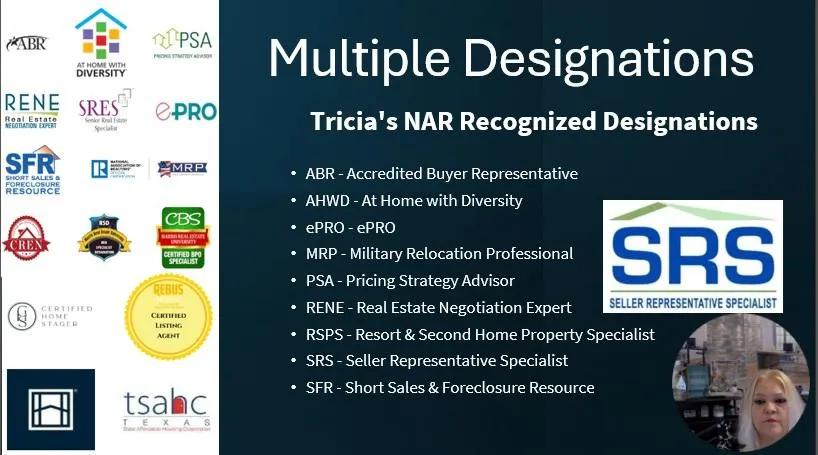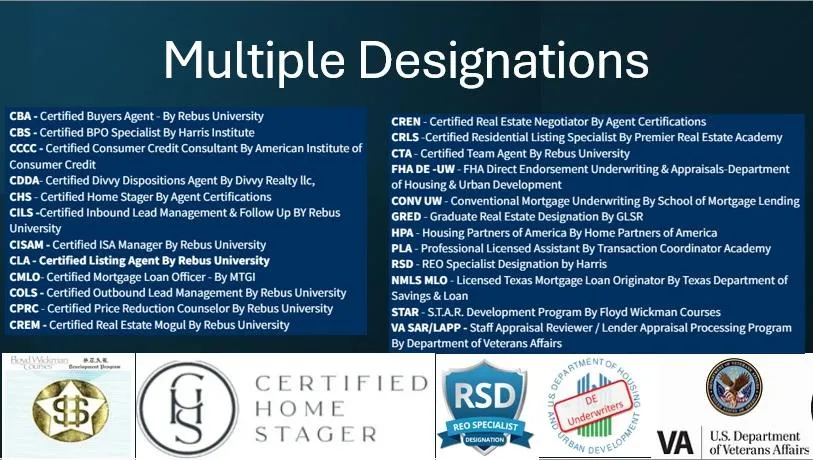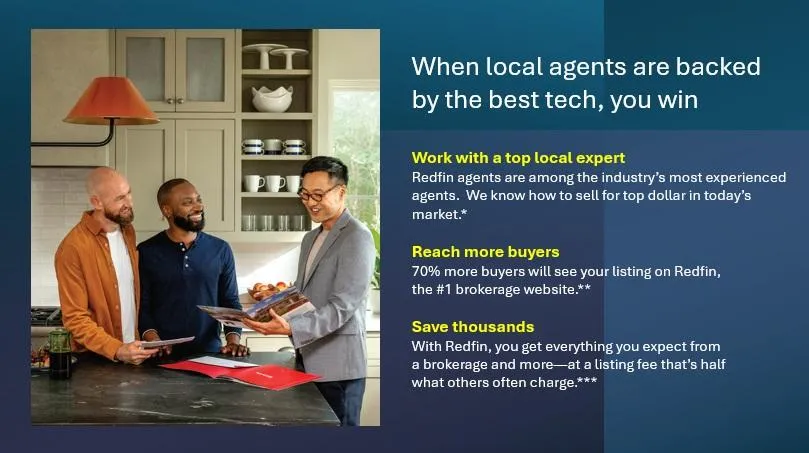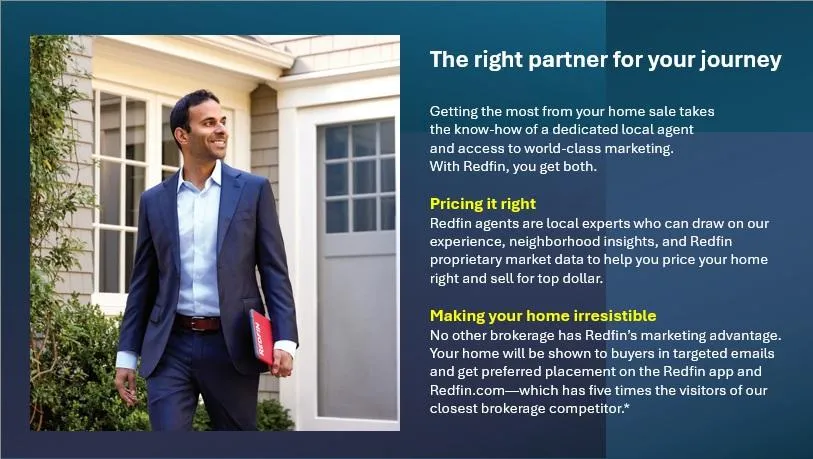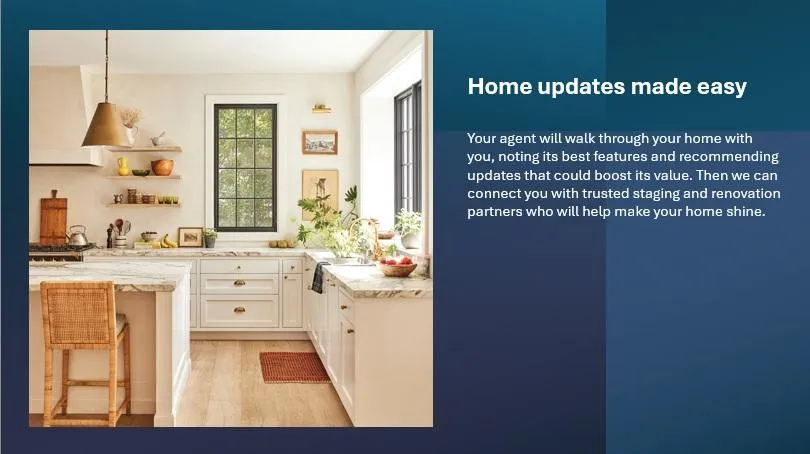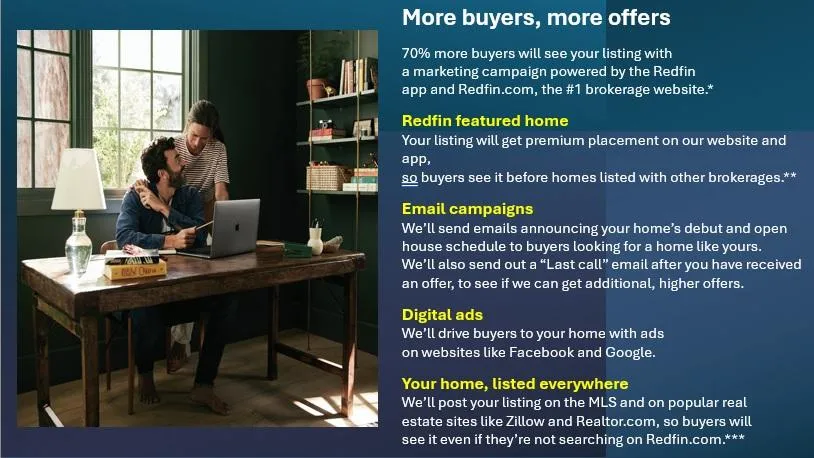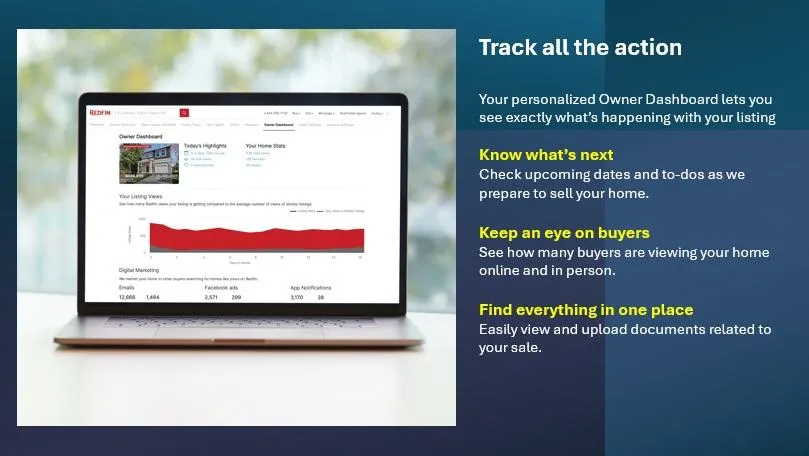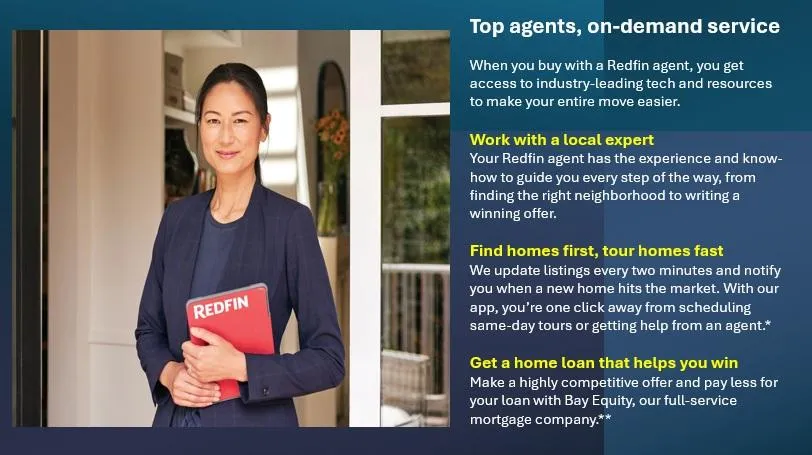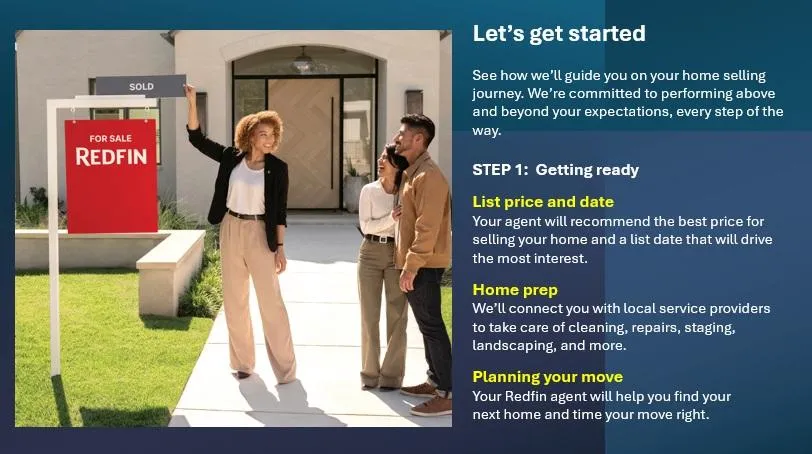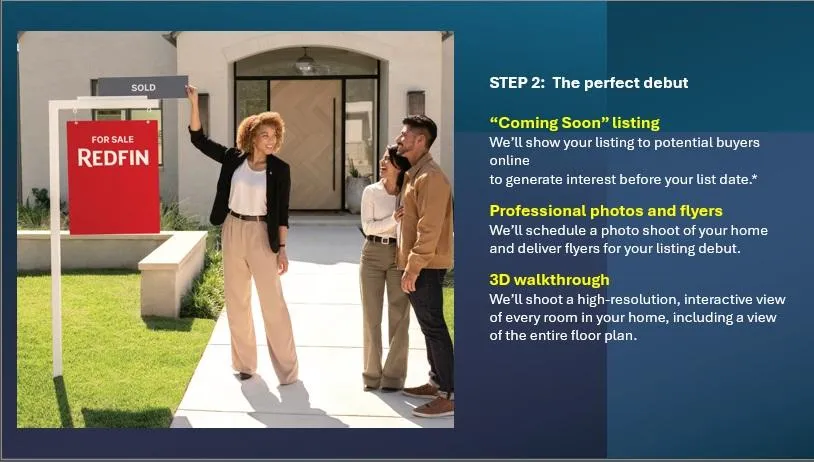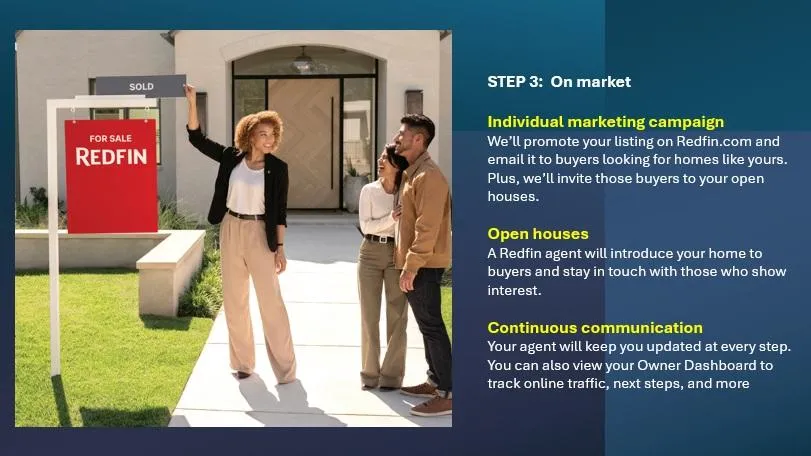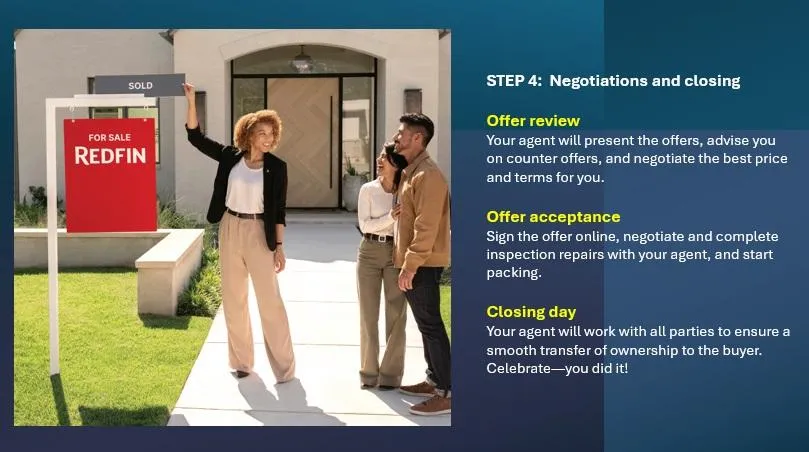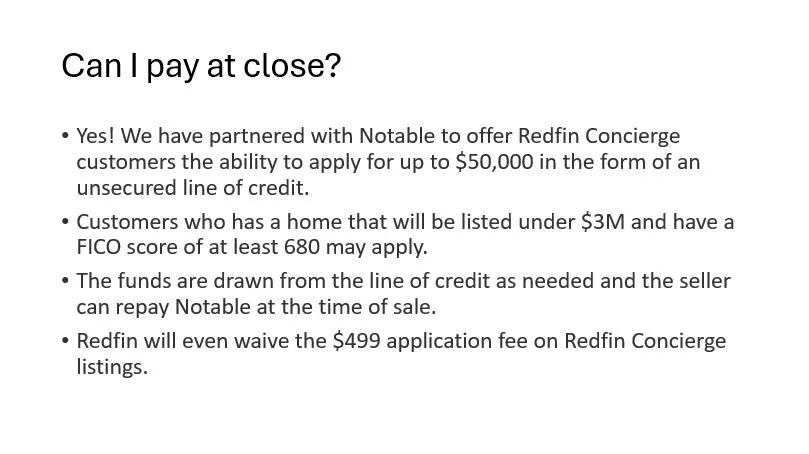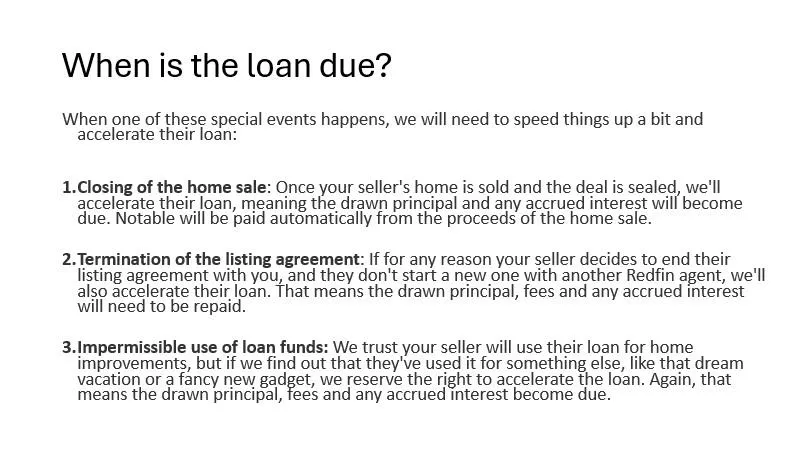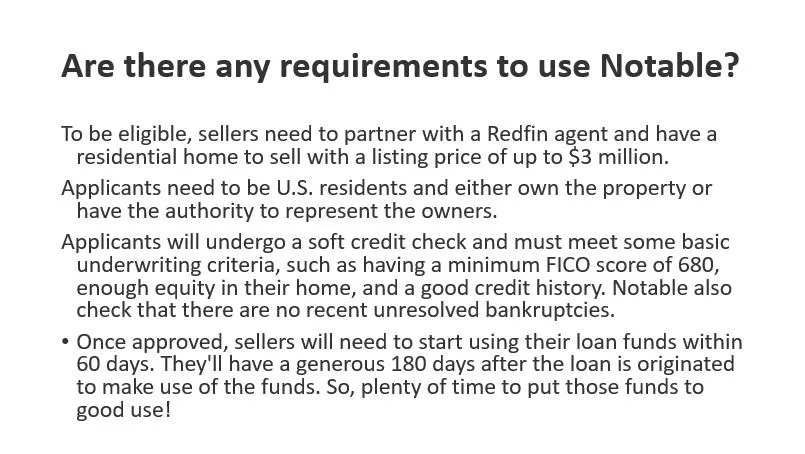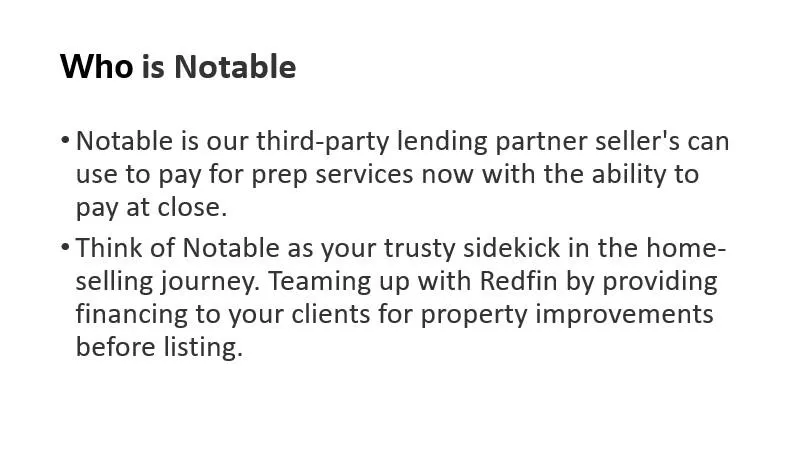Powered by

TREC # 605104

TRICIA MADRID, REALTOR®
TREC # 0461803
Pre-Listing Presentation
Your Dallas Fort Worth Texas Real Estate Agent
Here at Texas Elite Team, our primary objective is to expedite the sale of your DFW area home at a higher value, and to make your journey in finding and acquiring the ideal home smoother and more hassle-free. Discover our approach and how we achieve these goals.




LISTING CONSULTATION
PRIOR TO YOUR APPOINTMENT
Prior to our listing appointment, we invite you to take a few moments to watch this short series of videos designed to give you a better understanding of the selling process..
Click the buttons below to watch
Our Company
At Redfin, our mission is simple: to put the customer first in everything we do. As a tech-powered real estate company backed by a team of full-service, local agents, we combine innovative tools with personal service to deliver a smarter, more streamlined home buying and selling experience.
We are a client-focused team committed to honesty, integrity, and results. When you work with a Redfin agent, you’re not just getting a single agent—you’re backed by a full team of experts, advanced data insights, and a nationally recognized brokerage known for transparency and performance.
Our agents bring a deep understanding of the communities they serve, with insight into local schools, market trends, amenities, pricing, and neighborhood dynamics. Many of our agents are local residents themselves, giving them firsthand knowledge to help clients navigate both opportunities and challenges unique to each area.
Because the real estate market is constantly evolving, Redfin agents participate in regular training and ongoing education to stay current on market conditions, pricing strategies, and negotiation techniques. This ensures we’re always equipped to help our clients secure the best outcomes—whether buying, selling, or both.
Our professional standards are reflected in every detail, including the Comparative Market Analysis (CMA) you’ve received. This report provides accurate, real-time data to help price and market your home strategically. For most people, their home is their most valuable asset, and our goal is to provide the tools, expertise, and support needed to make every transaction smooth, informed, and successful.
Understanding a Comparative Market Analysis (CMA)
In simple terms, a Comparative Market Analysis, or CMA, is a professional report used to help determine the
current market value of your home. It relies on up-to-date local data and examines recently sold properties, homes currently under contract, and active listings in your area.
Using this information, we can recommend a listing price that reflects what the market is willing to pay. As the market evolves, this price may need to be adjusted to keep your home attractively priced and competitive with other properties.
The fair market value of a home is typically defined as the price a well-informed buyer and seller would agree to within a reasonable time frame—often within about 90 days. This value is not a guarantee, but rather an informed estimate that considers key factors such as location, property condition, and market demand . Adjustments may be needed based on interest levels, economic conditions, and buyer motivation.
The CMA you'll receive includes details about homes in your neighborhood that are similar in size, style, and features. While no two homes are exactly alike, the ones included in the report are the closest matches and are often the same properties appraisers use when evaluating value. We also consider important criteria like
square footage, neighborhood, upgrades, overall condition, and any existing financing terms.
All data used in your CMA comes from trusted industry sources, including local real estate brokerages, title companies, and the Multiple Listing Service (MLS) —the most accurate and comprehensive tool for real estate professionals.
What Determines the Value of Your Home
The value of a home is influenced by more than just its square footage or features. Several key elements come into play when determining its true market worth:
📍 Location
The saying “location, location, location” holds true — where your home is situated is often the most influential factor in determining its value. Proximity to schools, shopping, major roadways, and neighborhood desirability all play a role.
💰 Pricing
Setting the right price from day one is essential. A well-priced home attracts serious buyers and sells faster. This CMA helps us pinpoint a smart starting price. If the home doesn’t sell within a certain timeframe, price adjustments may be necessary to stay competitive.
🏠 Competing Homes
Buyers don’t shop in isolation. They’ll compare your home with others currently on the market, as well as recently sold properties nearby. Your home needs to stand out in both value and presentation.
🧼 Condition
First impressions count. Buyers respond emotionally and subjectively when touring homes. A well-maintained, clean, and visually appealing property — inside and out — makes a strong impact and can command a higher price.
📊 Current Market Conditions
The real estate market is always shifting. It’s influenced by factors beyond our control — such as supply and demand, interest rates, and economic trends. Distressed properties like foreclosures and short sales in the area can also affect your home's value. That’s why our marketing strategy must remain flexible and responsive to real-time changes.
Marketing Strategy Overview
📣 Marketing Strategy Overview
To successfully market your home, we follow a proven set of steps designed to maximize exposure and attract the right buyers. Here are just a few of the services we offer as part of our comprehensive home marketing strategy:
Before we begin, the first essential step is:
👉 Completing and signing the Listing Agreement.
This document allows us to officially represent you and launch the full marketing plan for your property.
Once that’s in place, we can move forward with customized marketing tailored to your home and local market.
Why Hire a Real Estate Professional
🏡 Why Hiring a Real Estate Professional Matters
Selling your home isn’t just about putting a sign in the yard — it’s a complex process that requires market insight, preparation, and expert guidance. Working with a real estate professional can make all the difference in getting the best price and a smooth transaction. Here’s where your agent truly earns their commission:
💲 Strategic Pricing
Setting the right price is critical. Price it too high, and your home may sit without offers. Too low, and you risk leaving money on the table. A real estate professional brings expert knowledge of local trends and comparable sales to position your home competitively from the start.
📣 Effective Marketing
Your agent will guide you on updates or small improvements that can increase appeal and value. Once listed, your home will be professionally marketed through online platforms, social media, email campaigns, and the agent’s network. Since most buyers start their search online, digital presence is key — and your agent knows how to maximize it without overexposing the property, which can sometimes signal distress to buyers.
🔐 Security & Supervised Showings
Your agent coordinates all showings to ensure only qualified buyers enter your home. This helps you plan ahead and provides peace of mind, knowing all visitors are pre-screened and accompanied.
🤝 Skilled Negotiation
Real estate professionals serve as neutral facilitators, helping both sides feel comfortable during negotiations. From crafting offers and counteroffers to managing emotions and expectations, your agent keeps everything on track — and in your best interest.
📑 From Contract to Closing
The journey doesn’t end with an accepted offer. Your agent helps you manage inspections, appraisals, title work, financing deadlines, and all the fine print. With a deep network of industry partners and the experience to navigate unexpected issues, your agent ensures you reach the closing table with confidence.
Intelligent Pricing & Perfect Timing
📈 Intelligent Pricing & Perfect Timing
Setting the right price at the right time is one of the most powerful tools you have when selling your home.
🎯 Smart Pricing Sells Homes
Buyers today are well-informed and constantly comparing homes. If your property is priced correctly from the start, it captures attention, drives more showings, and can generate stronger offers — sometimes even multiple. Overpricing, however, can cause your home to sit on the market, eventually leading to price reductions and less favorable outcomes.
⏳ Timing Is Everything
The first few weeks your home is on the market are the most critical. This is when it gets the most attention — from both buyers and agents. A well-timed launch, paired with the right price, creates a sense of urgency and excitement. Miss that window, and you may risk becoming "stale" in the market's eyes.
By combining real-time market data, local trends, and strategic timing, we position your home to sell faster and for top dollar — while minimizing stress and uncertainty along the way.
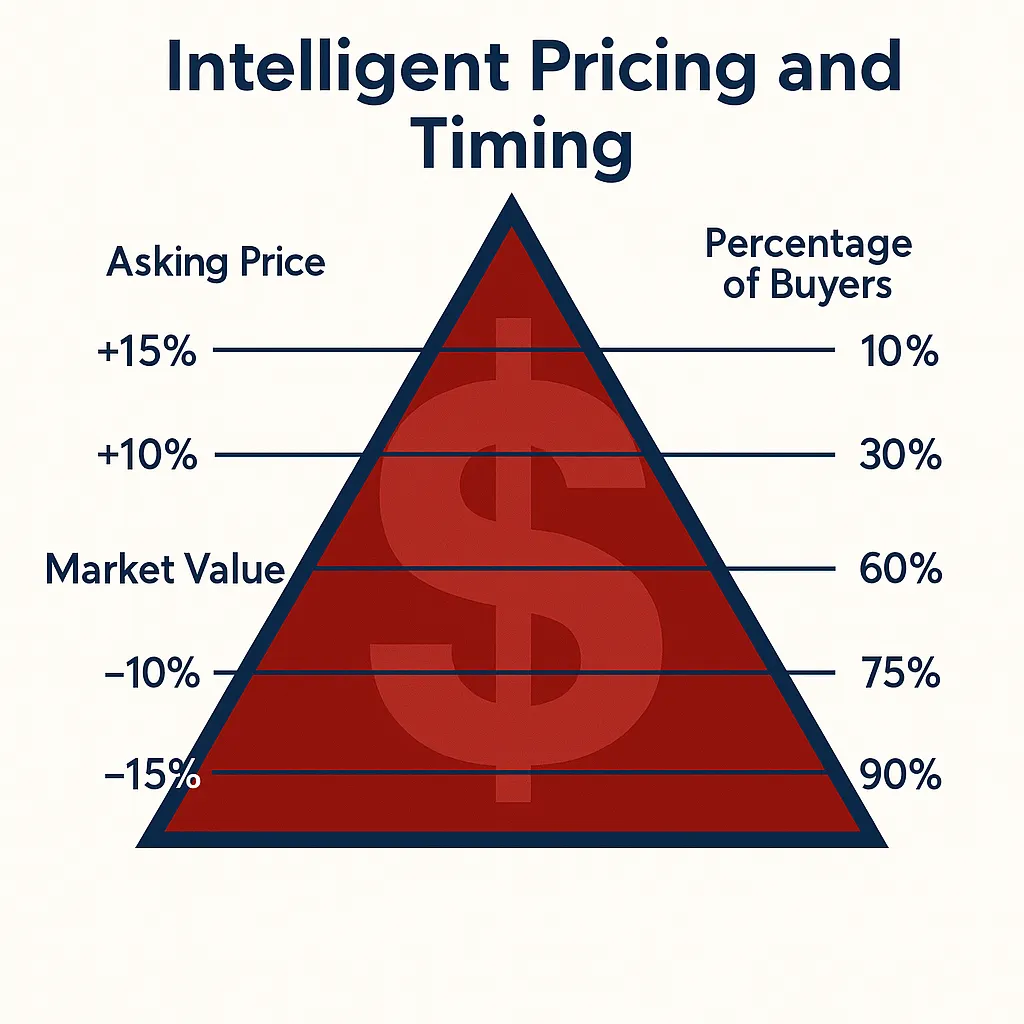
The pricing pyramid clearly shows that the closer a home is priced to its true market value, the more interest it generates from buyers. When priced above market value, fewer buyers engage — often leading to longer time on the market. However, when a home is strategically priced below market value, it tends to attract the highest number of potential buyers, creating more demand and sometimes even multiple offers.
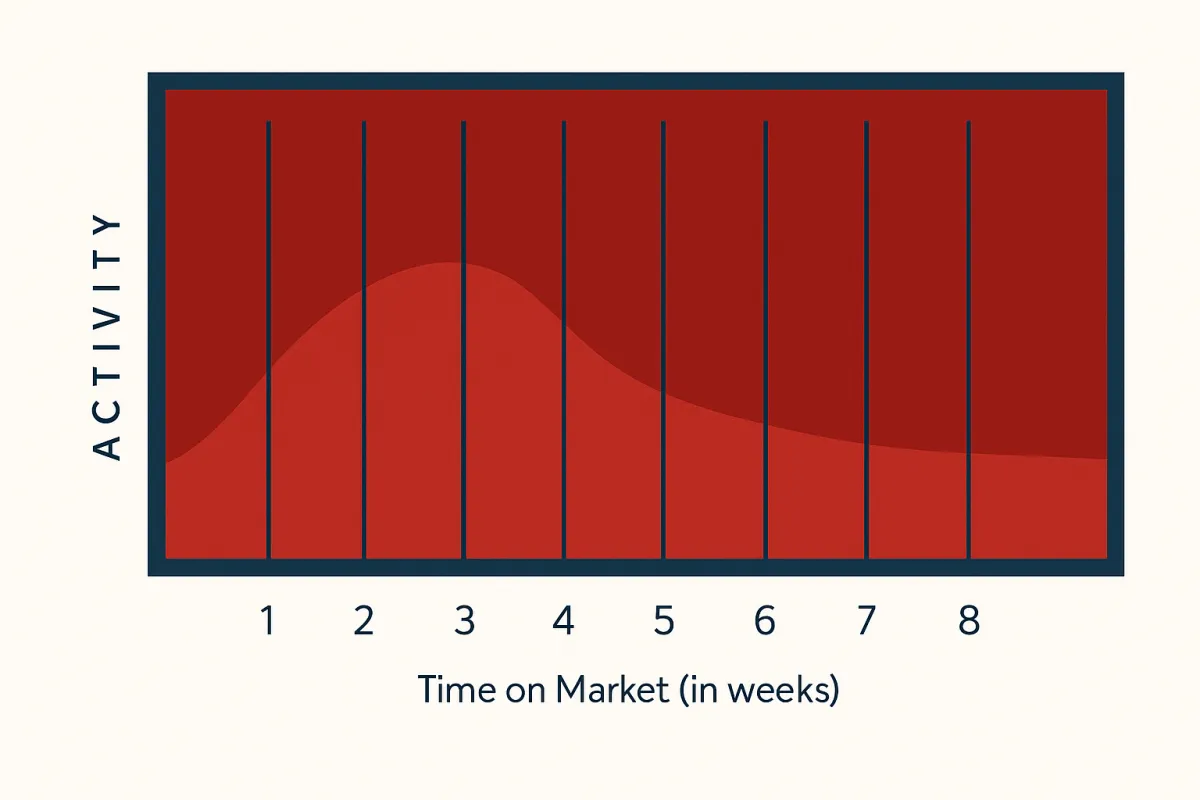
Pricing your home correctly from day one is critical. Buyer interest is at its highest the moment your property hits the market — that's when it captures the attention of the most real estate agents and serious buyers. This initial window is your best opportunity to sell at or near fair market value. Miss that moment, and interest tends to decline, often requiring price reductions to regain momentum.
Intelligent Pricing & Perfect Timing
🏡 First Impressions Are Lasting
Buyers begin forming opinions about your home the moment they pull up to the curb — and those first few seconds matter. A clean, well-maintained, and inviting home makes it easier for buyers to picture themselves living there, and can lead to faster, higher offers.
🌳 Exterior Appeal Matters
Curb Appeal is Key: Many buyers decide whether to consider a home before even stepping inside.
Ensure your property looks cared for from the outside.
Lawn & Landscaping: Keep the yard freshly mowed, flower beds weeded, and trees/shrubs trimmed.
Driveway & Garage: Clear the driveway of vehicles and debris. Keep the garage door closed when possible.
Roof & Gutters: Repair any loose shingles and clean out gutters for a polished appearance.
Walkways & Steps: Minimize visible cracks, remove clutter, and keep surfaces clean and safe.
Windows & Shutters: Check how your window coverings look from the street. Clean the windows for added shine.
Paint & Caulking: Touch up peeling paint and seal any gaps around windows or doors.
Pests: Address any signs of insects or rodents promptly.
Curbside Cleanliness: Remove pet waste, trash bins, or outdoor clutter. The goal is neat and welcoming.
🚪 Front Entrance: The Buyer’s First Pause
As buyers wait for the door to open, they notice everything — so make it count.
Sweep away cobwebs and dirt near the door, porch light, and entry windows.
Add seasonal flowers or plants to create warmth and charm.
Repaint the front door or touch up the trim for a fresh look.
🧼 Interior: Where First Impressions Are Confirmed
The inside should echo the care shown outside. Consider professional cleaning and staging techniques.
Declutter: Remove excess furniture and personal items to make rooms feel open and spacious.
Kitchen & Bathrooms: Keep countertops clear and sparkling. Staged simplicity looks best.
Storage Spaces: Buyers will open closets, cupboards, and even attic doors—keep them neat and organized.
Neutralize & Brighten: Soft, neutral tones and good lighting help rooms feel larger and more inviting.
Minor Repairs: Fix dripping faucets, replace burned-out bulbs, and patch wall damage.
✨ Create a Warm, Welcoming Atmosphere
Consider subtle, inviting scents like baked cookies or light potpourri.
Soft background music can set a relaxing tone.
Stage each bathroom with fresh, clean towels set aside just for showings.

What does the NAR Settlement Mean for you?
As a home seller, you have a wide range of choices when it comes to listing your home. Agents who are REALTORS® are a trusted source of advice and stand ready to help you navigate this complex process and make the choices that work best for you. NAR’s recent settlement has led to several changes related to broker commissions that benefit sellers, and we wanted to clearly lay them out for you. Here is what the settlement means for home sellers:
You still have the choice of offering compensation to buyer brokers. You may consider doing this as a way of marketing your home or making your listing more attractive to buyers.
Your agent must conspicuously disclose to you and obtain your approval for any payment or offer of payment that a listing broker will make to another broker acting for buyers.
This disclosure must be made to you in writing in advance of any payment or agreement to pay another broker acting for buyers, and must specify the amount or rate of such payment.
If you choose to approve an offer of compensation, there are changes to how this can happen.
You as the seller can still make an offer compensation, but your agent cannot include it on a Multiple Listing Service (MLS)—MLSs are local marketplaces used by both buyer brokers and listing brokers to share information about properties for sale.
Your agent can advertise your listing via off-MLS platforms such as social media, flyers and websites.
You as the seller can still offer buyer concessions on an MLS (for example, concessions for buyer closing costs).
These settlement practice changes went into effect August 17.
Here is what the settlement doesn’t change:
Agents who are REALTORS® are here to help you navigate the process of selling your home and are ethically obligated to work in your best interest.
Compensation for your agent remains fully negotiable, and if your agent is a REALTOR®, they must abide by the REALTOR® Code of Ethics and have clear and transparent discussions with you about compensation. When finding an agent to work with, ask questions about compensation and discuss what you would like to offer buyers.
You have choices. Work with your agent to understand the full range of these choices when selling your home, which will help you make the best possible decision for your needs.
More details about these changes and what they mean can be found at: facts.realtor
REALTORS® are members of the National Association of REALTORS®
Ten Jobs for Your Real Estate Professional
🔟 Ten Key Roles Your Real Estate Agent Handles for You
Selling your home is a significant life event — and a lot goes on behind the scenes to make it a success. That’s where your real estate professional comes in. From pricing to closing, your agent works hard to manage the complexities of the transaction while you focus on preparing your home and planning your move.
1. Accurate Home Pricing with a CMA
While you ultimately decide the list price, your agent provides a Comparative Market Analysis (CMA) that offers real-time insight into how similar homes are performing in your area — including those currently listed and recently sold — helping you price your home for maximum exposure and value.
2. Creating a Winning Sales Strategy
Your agent understands local trends, buyer behavior, and lending dynamics. They’ll help tailor a sales plan that aligns with your goals — whether you need a quick sale, top dollar, or strategic timing.
3. Professional Marketing & Exposure
From stunning photography and engaging home descriptions to MLS syndication, social media, and open houses — your agent ensures your home is seen by the right people in the right places at the right time.
4. Home Showings with Prequalified Buyers
Your agent helps coordinate showings and screens potential buyers so only serious, qualified prospects walk through your door — keeping your time and home secure.
5. Ongoing Communication & Market Updates
You’ll never be left in the dark. Your agent provides consistent updates, showing feedback, and insights into market shifts. Questions? You’re always welcome to reach out at any time.
6. Contract Review & Legal Oversight
Buyers typically submit offers using state-approved contracts. Your agent carefully reviews every detail to protect your interests, recommending edits or clarifications as needed to avoid confusion or risk.
7. Emotion-Free Negotiations
It’s easy to feel stressed or discouraged by lowball offers or heavy demands. Your agent acts as a calm, objective negotiator, keeping emotions out of the process and ensuring you remain in control of your bottom line.
8. Keeping the Deal Moving Forward
There are a lot of players involved — buyers, agents, lenders, inspectors, appraisers — and your agent coordinates them all. Their job is to keep the transaction on track so you don’t miss deadlines or lose momentum.
9. Closing Coordination
Once an agreement is in place, your agent hands the transaction off to a title company or attorney to prepare for closing. They’ll be by your side to ensure a smooth signing experience and help troubleshoot any last-minute issues.
10. Advocating for Your Success
Your agent has one mission: getting your home sold with as little stress and as much success as possible. Their business depends on results, referrals, and happy clients — so you can trust they’re working just as hard as you are to get to the finish line.
CMAs Aren’t Just for Sellers
📊CMAs Aren’t Just for Sellers — Buyers Benefit Too!
When it comes to determining what to offer on a home, it can be tricky — no two properties are exactly the same. While sellers traditionally use a Comparative Market Analysis (CMA) to set their asking price, savvy buyers should use this same tool to make smarter, more informed offer decisions.
🔍 What Is a CMA (Comparative Market Analysis)?
A CMA evaluates a home based on recent sales, current listings, and pending properties with similar features, location, and condition. For buyers, this is incredibly useful — it allows you to understand how the home you're considering compares to others in the neighborhood.
Ask your agent to run a CMA on any home you’re serious about —as if you were the seller — so you can better determine your offer strategy.
🧩 Every CMA Is Unique
Just as no two homes are alike, no two CMAs are identical. Your real estate professional uses MLS tools and pricing software to create a custom side-by-side comparison report. This includes:
Listing and sale prices
Square footage
Year built and updates
Lot size
Property style (single-family, condo, etc.)
Time on market
Location specifics
By reviewing this data, you’ll gain valuable insight into how your target home stacks up against other similar properties — helping you gauge what’s fair, what’s risky, and where you may have negotiating power.
🏷️ Determining a Strong Offer Price
A CMA can help answer important questions like:
How closely do comparable homes match the one you want to buy?
Are they located in the same neighborhood or nearby?
Are the homes the same size, style, or layout?
Do they offer similar numbers of bedrooms and bathrooms?
What type of property are they (condo, townhome, single-family)?
How long did they take to sell?
This analysis is a critical step in crafting a competitive yet smart offer — especially in fast-moving or multiple-offer markets.
⚠️ What a CMA Won’t Tell You
While a CMA reveals pricing patterns and trends, it won’t tell the full story.
For example:
You won’t see the condition of the roof, pool, or HVAC system
You won’t know if the home backs up to a highway or a serene greenbelt
You won’t know how modern or outdated the fixtures and finishes are
You won’t always see layout differences or upgrades that impact value
That’s why it's important to visit the homes or rely on your agent’s insight. A CMA is a guide — not a crystal ball. Your agent’s local knowledge helps fill in the blanks, providing the context and perspective needed to make a confident decision.
The Power of Communication
💬 The Power of Communication in Real Estate
The goal of great communication is simple: to understand and be understood. The more openly you communicate with your real state professional, the better equipped they’ll be to guide you, advocate for you, and help you make the most informed decisions possible.
🤝 Open Dialogue Creates Better Results
Ask questions — as many as you’d like. This isn’t just a transaction; it’s a personal milestone. Your agent is there to listen to your
goals, dreams, and any challenges you may be facing. The more your agent understands your vision, the more aligned your experience will be.
In return, be open to hearing your agent’s expert advice and professional insights. Trust is built through mutual respect and shared information — and that trust can make or break your experience.
🗣️ What Should You Share?
Here are some of the most important things to communicate with your real estate agent:
🎯 Your Goals
Is this a long-term home or an investment?
Are you relocating, downsizing, or upsizing?
What’s your ideal timeline to buy or sell?
❤️ Your Interests
Is being near a certain school, park, or commute route important?
Do you want walkability, a quiet street, or proximity to specific amenities?
What do other household members need or want?
🧩 Your Challenges
Do you need to sell your current home first?
Have you reviewed your credit or talked to a lender?
Do you have funds ready for your down payment and closing costs?
🏠 Your Lifestyle & Preferences
How many bedrooms or bathrooms will suit your family?
Do you prefer single-story, two-story, or split-level homes?
Are you drawn to a specific architectural style or neighborhood vibe?
🔑 Your Home Is More Than a Property — It’s Your Environment
You're not just buying or selling a structure. You’re choosing where your life will unfold — at least for the next several years. Every choice comes with trade-offs, and your agent can help you weigh both sides so you feel confident and comfortable.
With consistent, honest communication, your real estate professional becomes more than a guide — they become your advocate. Together, you can avoid pitfalls, uncover opportunities, and make decisions that truly align with your goals and lifestyle.
Think Like a Buyer
🧠 Think Like a Buyer
You’ve reviewed the Comparative Market Analysis, thought about your financial goals, and landed on a listing price. But before you finalize that number, it’s time to step into the buyer’s shoes. Ask yourself:
If I were shopping for a home today, would mine feel like a good value at this price?
💡 How Buyers Search for Homes
Buyers today are more informed than ever — most are already pre-approved and know exactly how much they can spend. They search by price brackets, usually in $25,000 increments , both online and with their agents. That means a home priced at $399,900 is more likely to appear in their search than one priced at $405,000.
To ensure your home reaches the right audience, it’s essential to price strategically — not emotionally.
📊 Buyers Compare Everything
After price, buyers look at what else is available in the area. They compare homes side-by-side, evaluating condition, features, and location. In a buyer’s market (when inventory is high), they have more leverage to negotiate. In a seller’s market (with low inventory), they’re often quicker to meet the seller’s terms — but only if the home presents strong value.
Ultimately, your home will land on a buyer’s shortlist only if it offers one of the best combinations of price, condition, and location
in their budget range.
📍 Setting the Right Asking Price
When evaluating comps, focus on homes that are:
In close proximity
Similar in square footage and layout
Comparable in age, style, and features
But don’t stop there. Market conditions matter. Prices fluctuate based on supply, demand, and buyer behavior. Some buyers will
compromise on condition to be in a preferred neighborhood. Others may choose more space or better updates in a less popular location.
Regardless, buyers buy value — not your backstory. They aren’t concerned with what you paid, how much you spent on upgrades, or how much profit you want. They care about whether your home feels worth the price in today’s market.
🛠️ Preparing to Compete
You can’t move your home to a better neighborhood — but you can improve its condition.
Fresh paint, new carpet, modern lighting, and minor repairs can all go a long way. The cleaner, fresher, and more up-to-date your home looks, the more likely it is to stand out in its price range.
Your goal is the same as the buyer’s: to make your home feel like the best deal on the block.
Emotional Triggers
🧠 Emotional Triggers: Engaging the Buyer’s Senses
Our five senses have the power to transport us — to holidays filled with laughter, cozy evenings by the fire, or childhood adventures. Homebuyers are no different. When they walk into a home, they’re not just evaluating walls and square footage — they’re imagining the next chapter of their lives.
Want to make your home unforgettable?
Here’s how to stimulate your buyer’s senses to create a lasting emotional connection.
👀 Sight: Create a Picture-Perfect Welcome
First impressions matter. Sweep the entryway, trim the shrubs, and add fresh flowers or potted plants near the door.
Small touches like a clean doormat or updated light fixtures signal care and warmth.
Inside, let your home breathe. Declutter and minimize decor so buyers can focus on the home’s features, not your belongings.
👂 Sound: Set the Mood
Turn off the TV and let the home speak. Light background music — soft jazz, classical, or acoustic — creates a calming atmosphere.
Silence squeaky hinges and creaky floors to remove distractions.
The right soundtrack says: "Take your time. Relax. Picture yourself here."
👃 Smell: Subtle Scents Sell Homes
Tempting aromas like fresh-baked cookies or simmering stew make a house feel like home.
Fresh flowers or herbs like eucalyptus, rosemary, or pine offer a natural, inviting scent.
Avoid artificial sprays or overpowering candles — clean is always the best fragrance.
Ensure pet areas are spotless and odor-free.
🤲 Touch: Invite Interaction
People are drawn to texture. A soft throw blanket, smooth countertops, and polished fixtures encourage buyers to touch — and what they touch, they’re more likely to want.
Clean surfaces and crisp linens signal care and comfort.
😋 Taste: Make Them Feel at Home
Offer light refreshments. In summer, chilled water or lemonade. In winter, warm cider or hot cocoa.
A small snack station with cookies, crackers, or cheese invites buyers to linger — especially in the kitchen, often the heart of the decision.
By appealing to all five senses, you create an experience buyers won’t forget. The more emotionally connected they feel, the more likely they are to picture themselves living there — and that’s what leads to offers.
Vetting Buyers
🕵️♂️ Vetting Buyers & Offers: How to Protect Your Interests and Stay Negotiation-Ready
Negotiation is a subtle art — and the best outcomes usually occur when both parties feel like they’ve won . For example, you may be open to accepting a slightly lower price if the buyer offers all cash or a faster closing . On the other hand, a buyer might offer full asking price, but request that you cover part of their closing costs.
In the end, buyers make decisions based on price, location, and condition — not on your personal circumstances or financial needs.
🔍 Step 1: Know Your Buyer
Before getting emotionally invested in an offer, confirm that the buyer is qualified and ready to proceed.
Ask your real estate agent to verify that the buyer has:
A preapproval letter from a lender or Proof of funds or a letter of credit for cash purchases
Once an offer is on the table, ask yourself:
"Is this offer reasonable given my home's value and the current market?"
If something seems off, lean on your agent to explain the offer's terms, background, and possible motivations. For instance, the buyer may be referencing a recent lower sale nearby that affects their perception of value — and your agent can help you
defend your price by highlighting your home’s condition, upgrades, lot size, or unique features.
📑 Step 2: Examine the Offer Details
Qualified buyers will often submit offers close to your asking price — but it’s common for them to include requests or contingencies, such as:
~ Including an excluded item like a designer light fixture or custom furniture
~ Requesting a delayed closing, early occupancy, or a rent-back agreement (especially for out-of-state relocations)
~ Proposing that you cover their closing costs
These types of requests aren’t unusual — but they should always be balanced with a strong purchase price. If a buyer asks for special accommodations, it’s fair to expect a premium price in return.
🤝 Step 3: Negotiation Tips
Buyers are driven by one question:
“Is this home worth the price to me?”
They don’t factor in your purchase price, personal expenses, or equity goals. Instead, they focus on how your home compares to others in terms of value.
If your property isn’t getting the offers you hoped for, condition may be the culprit. Ask your agent:
Which repairs or updates will give the best return on investment?
Are there concessions (like offering to pay HOA fees or a flooring allowance) that could sweeten the deal?
After making strategic improvements or price adjustments, you can:
Re-launch the listing
Re-engage interested buyers
Be better positioned to negotiate
Your real estate agent won’t tell you what price to accept — but they can advise you on how to improve your negotiating leverage
and protect your interests.
⚖️ Final Thoughts: Stay Focused on the Goal
Every change — whether it’s a counteroffer or a special request — reopens negotiations. Until both parties agree in writing, either side can walk away.
Don’t let a great buyer slip away over a minor issue. Keep perspective, stay flexible, and remember the ultimate goal:
✅ Getting your home sold — and moving forward with confidence.
What You Don't Know About Disclosures
📝 What You Don’t Know About Disclosures Can Hurt You
Whether you’re buying or selling a home, disclosures play a critical role in protecting both parties and ensuring a transparent transaction. Most states require sellers to share details about the condition of the property — including past repairs, known defects, and potential environmental concerns.
Understanding how disclosures work will help you avoid surprises, misunderstandings, or even legal issues down the line.
🧍♂️ For Sellers: Honesty is Protection
As a seller, your agent will provide you with the proper Property Disclosure Forms required in your state (commonly titled Seller’s Disclosure Notice , Condition Report, or Property Condition Statement).
You are expected to:
Disclose known issues, such as leaks, repairs, or environmental hazards (e.g., lead paint, radon)
Share documentation when available (like invoices or receipts for completed repairs)
Answer all questions to the best of your knowledge
💡Tip: If you're unsure whether to include something, it’s better to over-disclose than under-disclose. You can always check the “I Don’t Know” box — but only if that’s genuinely the case.
Keep in mind: Your real estate agent cannot fill out this form for you, but they can help clarify what it’s asking for.
🧍♀️ For Buyers: Read Carefully, Then Verify
The seller’s disclosure offers a helpful snapshot of the home's condition — but it’s not a guarantee. Be sure to:
Read the disclosure thoroughly and flag any red flags (e.g., past water damage, structural repairs)
If a seller states something like "leak repaired" — ask for proof and confirm what was done
Use common sense — if one bathroom had a failing shower pan, it’s worth checking others
Don't assume the disclosure covers everything — it only includes what the seller knows or is legally required to share
🛠️Your best defense: Hire a licensed professional home inspector.
A detailed inspection helps you assess current condition, uncover hidden problems, and determine whether the home is a solid investment.
⚠️ Understanding “As-Is” Sales
In some states, a seller can disclaim most disclosures and sell the home “ as is.”
This means:
The seller doesn’t guarantee the property’s condition
The buyer accepts the property with all its flaws
However, even in an as-is sale, sellers are still required to disclose known material defects. And they must complete
federally mandated disclosures , such as confirming the presence or absence of lead-based paint (for homes built before 1978).
Note: Sellers aren't expected to perform tests for things like mold, radon, or lead. But if they have done testing — or if remediation has taken place — they may need to provide supporting documentation.
🔑 Final Thought: Disclosures Build Trust
For sellers, thorough disclosure can help prevent disputes after closing . For buyers, reading disclosures carefully — and verifying with inspections — is key to making a confident purchase.
In real estate, what you don’t disclose (or fail to question) can come back to haunt you.
Clear, documented communication is the best way to keep everyone on the same page — and out of court.
Whether you’re buying or selling a home, disclosures play a critical role in protecting both parties and ensuring a transparent transaction. Most states require sellers to share details about the condition of the property — including past repairs, known defects, and potential environmental concerns.
Understanding how disclosures work will help you avoid surprises, misunderstandings, or even legal issues down the line.
🧍♂️ For Sellers: Honesty is Protection
As a seller, your agent will provide you with the proper Property Disclosure Forms required in your state (commonly titled Seller’s Disclosure Notice, Condition Report, or Property Condition Statement).
You are expected to:
Disclose known issues, such as leaks, repairs, or environmental hazards (e.g., lead paint, radon)
Share documentation when available (like invoices or receipts for completed repairs)
Answer all questions to the best of your knowledge
💡Tip: If you're unsure whether to include something, it’s better to over-disclose than under-disclose. You can always check the “I Don’t Know” box — but only if that’s genuinely the case.
Keep in mind: Your real estate agent cannot fill out this form for you, but they can help clarify what it’s asking for.
🧍♀️ For Buyers: Read Carefully, Then Verify
The seller’s disclosure offers a helpful snapshot of the home's condition — but it’s not a guarantee.
Be sure to:
Read the disclosure thoroughly and flag any red flags (e.g., past water damage, structural repairs)
If a seller states something like "leak repaired" — ask for proof and confirm what was done
Use common sense — if one bathroom had a failing shower pan, it’s worth checking others
Don't assume the disclosure covers everything — it only includes what the seller knows or is legally required to share
🛠️Your best defense : Hire a licensed professional home inspector.
A detailed inspection helps you assess current condition, uncover hidden problems, and determine whether the home is a solid investment.
⚠️ Understanding “As-Is” Sales
In some states, a seller can disclaim most disclosures and sell the home “
as is .”
This means:
The seller doesn’t guarantee the property’s condition
The buyer accepts the property with all its flaws
However, even in an as-is sale, sellers are still required to disclose known material defects. And they must complete federally mandated disclosures, such as confirming the presence or absence of lead-based paint (for homes built before 1978).
Note: Sellers aren't expected to perform tests for things like mold, radon, or lead. But if they have done testing — or if remediation has taken place — they may need to provide supporting documentation.
🔑 Final Thought: Disclosures Build Trust
For sellers, thorough disclosure can help prevent disputes after closing . For buyers, reading disclosures carefully — and verifying with inspections — is key to making a confident purchase.
In real estate, what you don’t disclose (or fail to question) can come back to haunt you.
Clear, documented communication is the best way to keep everyone on the same page — and out of court.
Don’t Choose Your Agent Based on List Price Alone
🚫 Don’t Choose Your Agent Based on List Price Alone
When interviewing multiple real estate agents, you're likely to hear a range of suggested listing prices for your home. And while it may be tempting to go with the agent who promises the highest number, that choice doesn’t always lead to the best results.
🎯 Some Agents Tell You What You Want to Hear — Not What You Need to Hear
Unfortunately, not all agents prioritize truth over tactics. Some will agree to list your home at an unrealistic price just to win the listing. It’s a strategy based on hope , not market data — and hope is not a sound marketing plan.
Just think of it like buying lottery tickets or betting in Vegas. The odds are against you, and disappointment is likely to follow. Listing high and waiting for magic to happen rarely leads to a quick sale — or top dollar.
🧠 Smart Pricing Comes from Market Knowledge
It takes a true professional to assess:
~ Whether we’re in a buyer’s or seller’s market
~ How rising interest rates affect demand
~ What buyers are actually paying for similar homes right now
~ How to use pricing strategically to generate strong offers early
There are two ways to price a home:
✅ List it where it will sell
❌ Or list it where it will sit
Where would you rather be?
📈 My Approach: Results, Not Guesswork
I focus on helping my clients sell for the highest possible price in the shortest amount of time — and that starts with data-backed pricing based on real market comps, not inflated guesses.
Would I work with you if you wanted to start high? Yes — as long as we’re aligned on the plan.
If no serious offers come in within 30 days, I’ll expect us to adjust the price to match market conditions. After all, the goal is to attract buyers, not chase them away.
Remember:
➡️ More buyers = more showings
➡️ More showings = more offers
➡️ More offers = stronger negotiation power — and top dollar for you
💼 I Don’t Measure Success by Listings Taken — I Measure It by Homes Sold
I don’t take on listings just to boost my portfolio. I take on clients I know I can serve successfully. That means giving you honest guidance, not false hope. Because in the end, your success is my success.
Let’s get your home sold — not just listed.
Home Features That Can Boost Your Property Value
🏡 Home Features That Can Boost Your Property Value
No two homes are exactly alike — and your property may have unique characteristics that add value beyond the basics. While renovations and upgrades certainly matter, there are other often-overlooked features that can positively influence your home’s market price.
Before finalizing your listing strategy, take a few moments to reflect on what makes your home stand out. Here are some value-enhancing features that buyers often pay a premium for:
🌳 Proximity to Parks
If your home is located within walking distance (approximately 1,500 feet) of a public park — whether it's a city green space, state park, or community trail — it could add 8–20% more value . Access to nature is a big draw for today’s buyers.
🏟️ Near Major Sports or Entertainment Venues
Living close to professional sports arenas or event centers can be a huge plus for buyers who love convenience and entertainment. While it may not appeal to every buyer, these properties often see strong appreciation due to location demand.
☕ Coffee Culture: The Starbucks Effect
Believe it or not, proximity to a Starbucks (or similar upscale coffee shop) has been linked to faster home appreciation. According to The New Rules of Real Estate by Zillow’s CEO and Chief Economist, homes near this popular brand tend to rise in value more quickly than homes farther away.
🌲 Mature Trees & Quality Landscaping
Curb appeal counts — and trees are surprisingly powerful when it comes to value. Mature, well-maintained trees (whether on your property or throughout the neighborhood) enhance the look and feel of the area and can lead to a measurable increase in value.
🚶♀️ Walkability to Daily Conveniences
Can you walk to a nearby grocery store, school, coffee shop, or park?
Walkability is one of the top lifestyle features today’s buyers seek. Even in suburban areas, being able to access key amenities without a car can raise your home’s desirability and price point.
🌅 The Power of a View
Two homes in the same neighborhood can vary widely in price — and a great view can make all the difference. Whether it’s overlooking green space, a body of water, or open skies, a scenic outlook adds emotional appeal and market value.
💡 Final Thought
As you prepare to list your home, don’t underestimate the value of unique location perks, aesthetic touches, and lifestyle advantages. These features, combined with strategic pricing and marketing, can make your home stand out — and sell for more.
Need help evaluating your home’s hidden value boosters? I’d be happy to walk you through a personalized pricing and positioning strategy.
Home Features That May Decrease Value
⚠️ Home Features That May Decrease Value
Just as certain features can boost your home’s appeal and price, others can have the opposite effect — sometimes without you even realizing it. Being aware of the potential turn-offs for buyers allows you to address them in advance and position your home more competitively in the market.
Here are some often-overlooked factors that may negatively impact your home’s value:
🚬 Lingering Indoor Smoke
While everyone has the right to enjoy their home as they choose, smoking indoors can leave behind strong odors that seep into carpets, walls, and furniture. Even with cleaning, the smell of smoke can be tough to fully eliminate — and it’s a major red flag for many buyers . If your home has been smoked in, it’s worth investing in deep cleaning or odor remediation before listing.
🐾 Odors of Any Kind
Many homeowners become “nose-blind” to smells in their own space. Pet odors, cooking smells, and moisture-related mildew can all influence a buyer’s first impression — and not in a good way. Address any lingering scents with professional cleaning, air purification, or deodorizers that don’t overwhelm but truly neutralize odors.
🚨 Higher Crime Rates in the Area
Whether or not you’ve noticed it, buyers will likely check the local crime data before making an offer — and so should you. Sites like
crimereports.com provide neighborhood comparisons. If your area has higher-than-average crime, it can impact buyer confidence and appraised value.
🎨 Overly Personalized Renovations
Your home should reflect your personality — but extremely unique renovations or bold design choices may limit your buyer pool. If you’ve installed ultra-modern fixtures in a traditional home, or painted every room in loud, trendy colors, it may make your home
feel less accessible to average buyers. Where possible, neutralize surfaces or update extreme choices to help buyers see the potential.
🌿 High-Maintenance Landscaping
A lush, well-manicured yard can impress — but if it looks too labor-intensive , some buyers will feel overwhelmed. Untamed lawns, overgrown flower beds, or elaborate gardens can come across as extra work instead of extra beauty. Before listing, simplify where you can, and make sure everything is trimmed, neat, and approachable.
🧹 Final Tip: Look Through the Buyer’s Eyes
When preparing to sell, the best mindset is to view your home as a product on the market. What will help it appeal to the
widest range of buyers ? Taking time to address small issues now can pay off in fewer days on market and stronger offers down the line.
🏚️ The Impact of Surrounding Homes on Your Property Value
You may have taken exceptional care of your home — but unfortunately,
your neighbors’ upkeep matters too. When it comes to appraisals and buyer impressions, your house doesn’t exist in a vacuum.
Appraisers don’t just evaluate your property; they also observe the overall condition of the surrounding homes. If nearby houses show signs of neglect — such as peeling paint, overgrown yards, or visible clutter — it can negatively affect your home’s appraised value , even if your property is immaculate.
While you can’t control your neighbors, you can:
~ Keep your property as pristine and inviting as possible
~ Enhance curb appeal with fresh landscaping and clean presentation
~ Consider speaking with neighbors (tactfully) if there’s a safety or HOA-related concern
Remember, buyers are purchasing more than a house — they’re buying into a neighborhood . The better the surroundings look, the more appealing your home becomes in their eyes.
Need help deciding which updates will make the biggest impact? I’m happy to walk through your home and offer personalized advice — with buyer psychology and market data in mind.
Pricing Above Market Value
💰 The Risks of Pricing Above Market Value
You may be tempted to "test the market" by pricing your home above what comparable properties have sold for. While it might seem like a bold move that could pay off, the reality is this strategy often works against sellers — not for them.
✅ The Rare Upside
Yes, there’s always a chance that the perfect buyer comes along, falls in love with your home, and is willing to pay a premium — potentially setting a new high for the neighborhood.
But let’s be honest:
That’s the exception, not the rule.
⚠️ The More Likely Outcome
Listing too high can result in:
Minimal interest from serious buyers
Agents ignoring your home entirely because it’s clearly overpriced
Missed exposure online when buyers filter search results by price
Extended days on market, which can make your home seem stale or undesirable
Ultimately, an expired listing with no sale
In today's digital-first world, buyers are savvy. They do their research, compare prices, and know when something is overpriced. Agents, too, will often skip over homes they know won’t appraise — not wanting to waste their client’s time.
🔍 What About the Appraisal?
Even if a buyer is willing to pay your inflated price,
the deal still has to pass the appraisal test.
Lenders base mortgage amounts on appraised value , not asking price. If the appraiser doesn’t believe your home is worth what the buyer offered — based on neighborhood comps and market conditions — the buyer may:
~ Be forced to walk away
~ Renegotiate a lower price
~ Or come up with the difference in cash (which is rare)
That means wasted time, frustration, and possibly a lost opportunity with a qualified buyer who would have purchased at the right price.
🧠 Pricing Smart = Selling Smart
As your real estate advisor, my role is to help you sell for the highest possible price the market will support — not to chase numbers that buyers and lenders won’t validate.
If you were a buyer and saw an obviously overpriced home, you’d probably ask:
"Why is it priced like that?"
…And then scroll right past it.
Let’s make sure that doesn’t happen to your home. Together, we’ll set a price that attracts the most attention, generates multiple offers, and positions you for a successful closing.
Pricing At Market Value
⚖️ Pricing at Fair Market Value: Why It Often Makes the Most Sense
Just like pricing above market value has pros and cons, setting your home’s price right at market value comes with its own advantages — and a few considerations. As your agent, my goal is to help you get the highest possible return in the shortest amount of time — and that starts with smart pricing.
Let’s take a look at why pricing at fair market value is often the sweet spot.
✅ Advantages of Pricing at Market Value
🌐 Increased Online Exposure
Today’s buyers begin their home search online — and price is the first filter they set.
By pricing your home where it truly belongs in the market, you make sure it shows up in the search results of
qualified buyers who can realistically afford it.
🤝 Attracts Buyer’s Agents
Buyer’s agents are constantly scanning listings that match their clients’ needs. If your home is priced appropriately, agents won’t hesitate to recommend it. When a listing is clearly overpriced or underpriced, it often raises red flags and gets passed over.
📝 Smoother Appraisal Process
When your home is priced at true market value, the appraisal is more likely to come in at or near contract price — reducing the risk of delays, renegotiations, or financing issues.
A realistic list price supports a cleaner, more confident transaction.
🤔 Is There a Downside?
The only real “con” to pricing at fair market value is a perception — the idea that you might be leaving money on the table.
But in most cases, fair pricing generates more interest and competition, and that can lead to:
~ Multiple offers
~ Bidding wars
~ A final sale price above asking
Negotiation plays a powerful role once you have the right buyer at the table.
🎯 What’s Next?
As your advisor, I’m here to help you determine the pricing strategy that aligns with:
~ Your goals
~ Your timeline
~ Current market conditions
There’s still one more strategy we should review before we finalize your ideal list price. Let’s explore that next so we can make the most informed, strategic decision together.
Pricing Below Market Value
💡 Pricing Below Market Value: A Strategic Move — When Used Wisely
Listing your home below fair market value doesn’t automatically mean you’ll walk away with less. In fact, under the right market conditions, pricing low can create high demand — sometimes resulting in a final sale price above asking.
Think of it like an auction: starting low gets more paddles in the air. Buyers feel like they’ve discovered a deal — and when multiple offers roll in, competition can quickly drive the price higher.
But this strategy isn’t right for every market or every seller. Let’s explore when it works best, and what you should consider first.
🔍 When Does This Strategy Make Sense?
Pricing below market value tends to be most effective in:
Balanced or high-inventory markets where buyers have choices and competition is moderate
Situations where you want to sell quickly or create urgency
Neighborhoods where homes are lingering on the market and you want yours to stand out
In low-inventory, hot markets where bidding wars are already common, pricing low may not be necessary — or may even backfire by attracting unqualified buyers.
Your real estate professional can help you assess the current market conditions to see if this approach is the right fit.
✅ Pros of Pricing Below Market Value
Attracts attention quickly from buyers and agents
Can create a multiple-offer situation, driving the final price higher
Often leads to a faster sale with shorter days on market
Generates excitement and urgency
⚠️ Potential Cons to Consider
Some buyers may be qualified for your asking price but not for the competitive offer amount, which can cause financing challenges
If demand doesn’t materialize, you could end up selling below your home’s true value May draw in bargain hunters instead of serious, well-matched buyers
🎯 Final Thought
Used strategically, pricing below market value can be a powerful way to spark interest, boost visibility, and generate strong offers. But it requires careful timing, thorough market knowledge, and a well-executed marketing plan.
Let’s evaluate if this approach aligns with your home, your goals, and the current buyer landscape. Together, we’ll find the pricing strategy that gets you the best outcome possible.
Choose Your Pricing Strategy
📌 Choose Your Pricing Strategy
Now that we’ve reviewed the three main pricing approaches, it’s time to decide which strategy best fits your goals, your timeline, and the current market conditions.
Please select the option you feel most comfortable with:
⬜ Price Above Market Value
“We want to test the waters at a higher price and are okay with a longer time on market.”
⬜ Price at Market Value
“We want to attract serious buyers quickly and aim for a strong, smooth transaction.”
⬜ Price Below Market Value
“We want to generate interest fast and potentially spark a bidding war.”
Showing & Open House Checklist
🏡 Showings & Open House Checklist
Keep Your Home "Show Ready" — Every Time a Buyer Walks Through
Once your home hits the market, every showing is an opportunity to make a great first impression. Use this checklist to ensure your home is always staged to sell — even on short notice.
🧼 General Prep
✔ Review your First Impressions guide
✔ Complete all minor repairs (inside & out)
✔ Eliminate clutter throughout the home
✔ Open blinds/drapes — let natural light in
✔ Turn on all lights — brighten up each room
✔ Add welcoming touches: fresh flowers, candy dish, or seasonal decor
🍽 Kitchen
✔ Dishes cleaned and put away
✔ Counters wiped down and cleared off
✔ Trash emptied
✔ Consider simmering vanilla or cinnamon, or baking cookies for a cozy aroma
🍷 Dining Room
✔ Table centerpiece displayed
✔ Dining table set with China or tasteful place settings
✔ Chandelier or lighting turned on
🛁 Bathrooms
✔ All surfaces cleaned and wiped down
✔ Toilet lids closed
✔ Fresh towels neatly hung
✔ Toilet paper restocked
✔ Softly scented potpourri or diffuser in place
🛏 Bedrooms
✔ Beds neatly made
✔ Clothing, shoes, and personal items stored away
✔ Nightstands and dressers decluttered
✔ Closets straightened (buyers will peek inside)
🛋 Living Areas (Living Room, Family Room, Den)
✔ Pillows fluffed and furniture arranged neatly
✔ Coffee tables, side tables, and media centers cleared
✔ Wall art and decor adjusted for symmetry
✔ Consider fresh plants or a simple floral arrangement for a welcoming feel
🚪 Final Walkthrough Tips Before You Go:
Take out the trash
Tuck away pet beds and bowls
Set a comfortable temperature
Leave soft background music playing
Step outside and view your home like a buyer would
✨Buyers decide within seconds — let’s make every showing a “Wow!” moment.
Mega Open Houses
🎉 What is a Mega Open House ?
When you hire me as your dedicated real estate professional, you’re not just getting standard marketing — you’re getting
maximum exposure. One of my most powerful selling tools is what I call the Mega Open House— a high-energy, highly marketed event designed to create buzz, draw serious buyers, and position your home as the most talked-about property in the neighborhood.
🏡 So, What Makes It “Mega”?
Unlike a traditional open house, a Mega Open House is a full-day, community-focused event with two main phases:
🥂 1. Seller’s Lunch & Neighborhood Social
Time: 11:30 AM – 1:00 PM
We kick things off with a private invite-only Seller’s Lunch, where you and your neighbors get a chance to connect, say farewell, and chat with me about the current real estate market. This portion is all about building goodwill, getting local word-of-mouth buzz going, and showing neighbors how much you care about their community.
🚪 2. Public Mega Open House
Time: 1:00 PM – 4:00 PM
After the lunch wraps up, it’s time for showtime . I’ll ask that you and your guests head out so I can professionally host the open house and focus on prospective buyers. This segment is open to the public and will be heavily promoted to maximize foot traffic and generate interest.
📣 Marketing Blitz: How We Promote It
To ensure this event is a success, I launch a multi-channel marketing campaign that includes:
A custom invitation video sent to my network (and shared through yours, too!)
Direct mail invitations to the neighborhood
Door knocking and personal invites
Dozens of strategically placed signs throughout nearby intersections to guide traffic
Promotion across MLS, social media, and buyer networks
🤝 What You’ll Be Doing
Greeting neighbors at the Seller’s Lunch with me at the front door
Enjoying time with your community while I build excitement about your listing
Relaxing during the open house while I take over, showcase your home, and capture leads
Letting me follow up with every visitor immediately after the event
🧲 Why It Works
The Mega Open House:
Creates urgency and competition among buyers
Generates neighborhood buzz and word-of-mouth referrals
Builds community goodwill
Captures more qualified leads in a single day than most listings get in a week
Shows your home in the best possible light, with a full marketing push behind it
If you choose to list your home with me, this is just one of the many high-impact strategies I’ll implement to help you sell quickly and for top dollar.
Let’s make your Mega Open House a mega success!
Thinking About Selling Your Home Yourself?
🤔 Thinking About Selling Your Home Yourself?
It’s not uncommon for homeowners to consider selling without a real estate agent — and at first glance, it may seem like a way to save money on commissions. But while the idea sounds appealing, the reality often tells a different story.
📉 FSBO Results: Do You Really Save?
Statistics show that homes sold by owners (FSBOs) typically sell for less than homes listed by a real estate professional — often
significantly less. That means what you may “save” in commissions could be lost (and then some) in the final sale price.
🛑 The Biggest Difference Is Marketing
No matter how beautiful your home is, it won’t sell if no one knows it’s available — or if it blends into the crowd. The way your home is marketed makes all the difference between one that sells quickly at top dollar and one that lingers on the market, growing stale.
There are two basic marketing approaches:
⚙️ Passive Marketing
This is the typical “set it and forget it” approach. You put out a sign, run an ad, maybe host an open house — and hope the right buyer comes along.
While this may sound proactive, it's what most FSBOs and many agents do — and in a competitive market, it’s simply not enough.
🚀 Active Marketing
This is where I come in. As your agent, I take an aggressive, hands-on approach to get your home seen by the right people.
I make personal calls daily to agents, buyers, and referral networks
I market across MLS, social media, video, email, and direct campaigns
I leverage my professional network to bring qualified, motivated buyers to your doorstep
In short, I treat your listing like a business launch , not a passive listing. Because that’s exactly what it deserves.
⏳ Time, Negotiation & Risk
Selling a home is a full-time job — involving pricing, prep, photography, showings, legal documents, disclosures, inspections, repairs, and contract negotiation. One wrong move can cost you thousands or even delay the sale altogether.
When you work with me:
Your interests are protected
Your deal is negotiated with strategy and precision
Your closing is managed every step of the way
🎰 The Vegas Analogy
Sure, some FSBOs succeed — just like some people
hit the jackpot in Vegas. But ask yourself:
If everyone was winning, would the casinos still be in business?
Likewise, if selling your home yourself was so simple and profitable, real estate professionals wouldn’t be closing 90%+ of all residential sales.
💬 Final Thought
At the end of the day, it’s your decision. But before you roll the dice, let’s have a quick conversation. I’ll show you exactly how I can
maximize your profit, minimize your stress, and protect your investment from listing to closing.
You deserve more than luck. You deserve a strategy.
Don't Wait to List Your Home
⏰ Don’t Wait to List Your Home
You might be thinking about delaying your listing — and in certain markets, that may feel like the safe move. But in today’s shifting real estate landscape, waiting could actually cost you time, money, and leverage.
Whether you’re prepping for the holidays, trying to finish up projects, or just unsure of the timing, here’s why now may be the best time to act.
🔨 Still Finishing Projects? Don’t Let That Hold You Back.
It’s common for homeowners to want everything “just right” before going live — but here’s the truth:
Many buyers aren’t expecting perfection . In fact, they often prefer to make cosmetic updates themselves, and many even request changes during escrow.
Instead of spending extra time (and money) on a remodel that might not even align with your buyer’s preferences, consider this approach:
~ List now and get real-time feedback from buyers and agents
~ Prioritize only the repairs that truly impact marketability
~ Let the buyer handle the upgrades they want — on their own dime
🎄 Worried About Listing During the Holidays? Here’s Why You Shouldn’t Be.
It’s a common myth that the holidays are a bad time to sell. In fact, this season can give you a distinct edge:
Inventory is low, meaning less competition from other sellers
Buyers shopping during this time are highly motivated
Serious buyers often want to close quickly, giving you the advantage
And don’t worry — when we work together, I’ll make sure to honor the days you want to keep private. You can enjoy your holiday season without interruptions, while I continue to market your home strategically behind the scenes.
📈 The January Rush = More Competition
While many sellers wait for the new year, inventory typically spikes after January 1st. That means:
~ More homes hit the market
~ More competition for buyer attention
~ Less negotiating power for you
By starting now, you’ll be ahead of the surge — with buyers already lined up before others even list.
📋 Let’s Prepare Now, Launch Strategically
We can start with:
A pre-listing consultation
Professional photography
Early online marketing teasers
Gathering buyer interest in advance
So when you’re ready to go live, your home launches ahead of the competition — with momentum already in your favor.
💬 Final Thought
Waiting might feel comfortable, but in real estate, timing is everything. Let’s talk about your goals and build a plan that balances your schedule with today’s buyer demand.
Selling during the holidays isn’t just possible — it can be powerful.
Let’s make it work for you.
Your Moving Checklist
📦 Your Moving Checklist
A step-by-step guide to make your move as stress-free and organized as possible!
✅ Several Weeks Before Moving Day
🧹 Declutter: Sort through belongings and donate, sell, or discard anything you no longer need.
🚛 Get Moving Quotes: Contact multiple moving companies and compare services, availability, and pricing.
📞 Notify Utility Providers: Schedule disconnection for your current home and activation at your new address.
🏥 Medical Prep: Refill prescriptions or transfer them to your new pharmacy, Get referrals for new doctors, dentists, and specialists, Collect medical, dental, vaccination, and school records
🐾 Pet Planning: Arrange pet transportation or boarding if needed.
📦 Start Packing: Gather packing supplies and begin boxing non-essentials. Label everything clearly.
📬 Change of Address: Notify the post office, banks, credit cards, subscriptions, and important contacts.
❌ Cancel Local Services: End things like lawn care, pest control, newspaper delivery, etc.
🧊 Use Up Perishables: Empty out the fridge, freezer, and pantry in the final days.
🚚 Moving Day Must-Dos
💳 Prepare Payment: Have payment ready for movers (check if they accept credit/debit or only cash).
💰 Carry Cash: Keep cash or traveler's checks for meals, fuel, tips, or emergencies.
🔐 Secure Valuables: Personally transport important documents, jewelry, and sensitive items.
🧽 Final Sweep: Check closets, drawers, shelves, and the garage — don’t leave anything behind.
🧒 Plan for Kids & Pets: Arrange supervision so the move runs smoothly and safely.
🧼 Clean Up: Give the home a final tidy. Consider hiring a cleaning service if time is tight.
📮 Leave Contact Info: Provide your new address to the buyers or new residents for forwarding stray mail.
🗝️ Return Keys: Drop off all house keys to your real estate agent or designated contact.
🏠 After You Move In
🚘 Register Your Car (if out-of-state): Do this within 5 days to avoid penalties.
📇 Update Your ID: Apply for a new driver’s license if needed.
🏫 Enroll in School: Register children and request any necessary academic records.
🗳️ Register to Vote: Update your voter registration based on your new address.
📋 Check for Damage: Photograph and document any damaged items. Keep packaging for insurance claims.
🏡 Settle In: Unpack essentials first, take your time, and enjoy your new home!
💬 Final Tip:
Planning ahead is the key to a smooth move.
If you need referrals for movers, cleaners, handymen, or anything else — I’m just a call or text away!
Thank You!
Thank You!
Dear Seller,
I know you have many choices when it comes to selecting a real estate professional, so I want to sincerely thank you for considering me. It means a great deal to have the opportunity to sit down with you and discuss how we can work together to get your home sold.
I take this responsibility seriously. You can count on me to arrive fully prepared, use our time efficiently, and most importantly — answer all your questions with honesty and clarity.
My goal is simple:
To help you sell your home for the highest possible price, in the shortest amount of time, with the least amount of stress. I want you to walk away from this experience feeling confident, well-cared for, and successful — because that’s what you deserve.
In the packet we provide, you’ll find:
~ Reviews from past clients who have trusted me with their home sale
~ A detailed outline of my Marketing Action Plan
~ Information we’ll review together, including a Comparative Market Analysis (CMA) tailored to your home
When you’ve had a chance to review the materials, please send me a quick confirmation — that way, I’ll know we’re aligned before our appointment.
Once again, thank you for the opportunity. I look forward to meeting you in person and showing you how I can help make this move a smooth and successful one.
Warm regards,
Tricia Madrid
Your Trusted Real Estate Professional
Let's Get Started

Thank you for the opportunity to work together on the sale of your home.
Tricia Madrid
Sr. Agent, Realtor
Team Lead- Texas Elite Team
(682) 777-3950
www.texaseliteteam.com
My Testimonials
The links below will take you to several of my Testimonial sites where we would appreciate your sharing your

Thank you for the opportunity to work together on the sale of your home.

“Her commitment to ensuring my understanding and confidence in this process has made this journey both informative and rewarding.”
Tricia embodies qualities that truly stand out - her expertise, unwavering patience, and professionalism. As a first-time home buyer navigating uncharted territory, I found myself relatively inexperienced in the process. Tricia stepped in, dedicating her time to meticulously guide me through every aspect, ensuring I grasped the nuances involved. Her responsiveness was remarkable - whenever I expressed interest in a property, her swift reply of "I will get that set up!" was reassuring.
Her flexibility in accommodating viewing schedules and her constant availability for my inquiries made the journey smoother. Tricia didn't merely showcase homes; she delved into thorough explanations, shedding light on intricate details and potential risks associated with each property. Her transparency and honesty were invaluable, earning my deep appreciation.
Tricia's unwavering dedication to helping me discover the perfect home has been evident throughout our interactions. Her commitment to ensuring my understanding and confidence in this process has made this journey both informative and rewarding. I am positive that I will find my dream home with the help of Tricia!
La Tonya W – January 2024
“She was very nice she went above and beyond working with me to get me a home that is within my needs”
She was very nice she went above and beyond working with me to get me a home that is within my needs and my children. I wanted to stayed with the HEB area and we look for about I lost count but she never gave up. Tricia is very kind and patience explaining being a homeowner since this was my first home
~ Josephine Dankwa


Serving DFW Metroplex
TEXAS ELITE TEAM
2611 Internet Blvd, Suite 201
Frisco, TX 75034
Phone: (682) 777-3950
Follow Us
Call Us!
(682) 777-3950

MLS Information Deemed Reliable But Not Guaranteed. This information is being provided by the NTREIS MLS. All data, including all measurements and calculations of area, is obtained from various sources and has not been, and will not be, verified by broker or MLS. All information should be independently reviewed and verified for accuracy. Properties may or may not be listed by the office/agent presenting the information.
TRICIA MADRID -TEXAS ELITE TEAM is a licensed Agent in the state of Texas and is a leading authority on DFW Metroplex, Our love for the communities we live and work in are why we do what we do. Stop by the office and experience the Texas Elite Team way of DFW area real estate.
@ 2024 TEXAS ELITE TEAM

TEXAS ELITE TEAM
Texas Elite Team
4314 Blossom Valley Lane
Richmond, TX 77469
Phone: (682) 777-3950
Email us!
Like Us
MLS Information Deemed Reliable But Not Guaranteed. This information is being provided by the NTREIS MLS. All data, including all measurements and calculations of area, is obtained from
various sources and has not been, and will not be, verified by broker or MLS. All information should be independently reviewed and verified for accuracy. Properties may or may not be listed by the office/agent presenting the information.
TEXAS ELITE TEAMis a licensed Agent in the state of Texas and is a leading authority on DFW Metroplex, Our love for the communities we live and work in are why we do what we do. Stop by the office and experience the Texas Elite Team way of DFW area real estate.
Call Us!
(682) 777-3950


Sell Your House
How It Works
Contact Us
Blog
Hud Homes
Good Neighbor Next Door Program
FREE Home Value Analysis
Buy A House
Our Company
Privacy Policy
Prevent Foreclosure
© 2024 TEXAS ELITE TEAM
